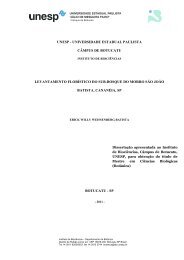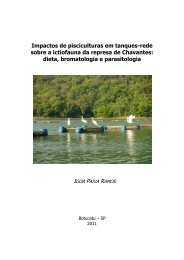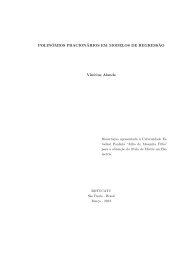- Page 1 and 2:
Universidade Estadual Paulista “J
- Page 3:
AGRADECIMENTOSÀ minha orientadora
- Page 10 and 11:
LISTA DE FIGURASFigura 1 A - Freqü
- Page 12 and 13:
sonda A_14_P131252 que mapeia o gen
- Page 14 and 15:
esultante da análise do SAM (Tushe
- Page 16 and 17:
Figura 33 Agrupamento hierárquico
- Page 18 and 19:
LISTA DE TABELASQuadro 1Relação d
- Page 20 and 21:
LISTA DE SIGLAS E ABREVIATURASANG A
- Page 22 and 23:
SUMÁRIO1 Introdução ............
- Page 24 and 25:
Cirilo, PDRINTRODUÇÃO11. Introdu
- Page 26 and 27:
Cirilo, PDRINTRODUÇÃO3dados em li
- Page 28 and 29:
Cirilo, PDRINTRODUÇÃO5infertilida
- Page 30 and 31:
Cirilo, PDRINTRODUÇÃO7foram despe
- Page 32 and 33:
Cirilo, PDRINTRODUÇÃO9(10q24.33),
- Page 34 and 35:
Cirilo, PDRINTRODUÇÃO11somente fo
- Page 36 and 37:
Cirilo, PDRINTRODUÇÃO13Segundo a
- Page 38 and 39:
Cirilo, PDRINTRODUÇÃO15(Sargent e
- Page 40 and 41:
Cirilo, PDRINTRODUÇÃO171 geralmen
- Page 42 and 43:
Cirilo, PDRINTRODUÇÃO19transcrita
- Page 44 and 45:
Cirilo, PDRINTRODUÇÃO21amostras.
- Page 46 and 47:
Cirilo, PDRINTRODUÇÃO23evento que
- Page 48 and 49:
Cirilo, PDRINTRODUÇÃO25também os
- Page 50 and 51:
Cirilo, PDRINTRODUÇÃO27tratamento
- Page 52 and 53:
Cirilo, PDRINTRODUÇÃO29Hodge et a
- Page 54 and 55:
Cirilo, PDRMATERIAL E MÉTODOS313.
- Page 56 and 57:
Cirilo, PDRMATERIAL E MÉTODOS33Tam
- Page 58 and 59:
Cirilo, PDRMATERIAL E MÉTODOS35for
- Page 60 and 61:
Cirilo, PDRMATERIAL E MÉTODOS370,1
- Page 62 and 63:
Cirilo, PDRMATERIAL E MÉTODOS39alt
- Page 64 and 65:
Cirilo, PDRMATERIAL E MÉTODOS413)
- Page 66 and 67:
Cirilo, PDRRESULTADOS43Tabela 1. Da
- Page 68 and 69:
Cirilo, PDRRESULTADOS45ABFigura 1.
- Page 70 and 71:
Cirilo, PDRRESULTADOS47Este estudo
- Page 72 and 73:
Cirilo, PDRRESULTADOS494.2.1 Caract
- Page 74 and 75:
Cirilo, PDRRESULTADOS51Entre as 45
- Page 76 and 77:
Cirilo, PDRRESULTADOS53(10%)Cromoss
- Page 78 and 79:
Cirilo, PDRRESULTADOS55Cromossomo 1
- Page 80 and 81:
Cirilo, PDRRESULTADOS574.2.2 Tumore
- Page 82 and 83:
Cirilo, PDRRESULTADOS59Tabela 4. De
- Page 84 and 85:
Cirilo, PDRRESULTADOS61629T 629T_A,
- Page 86 and 87:
Cirilo, PDRRESULTADOS63279,263-1,48
- Page 88 and 89:
Cirilo, PDRRESULTADOS65ABFigura 7.
- Page 90 and 91:
Cirilo, PDRRESULTADOS67ABFigura 8 -
- Page 92 and 93:
ABCirilo, PDRRESULTADOS69Figura 10.
- Page 94 and 95:
Cirilo, PDRRESULTADOS71Figura 11. A
- Page 96 and 97:
Cirilo, PDRRESULTADOS73Grupo 1tumor
- Page 98 and 99:
Cirilo, PDRRESULTADOS75Figura 14. A
- Page 100 and 101:
Cirilo, PDRRESULTADOS77631T_C 99,55
- Page 102 and 103:
Cirilo, PDRRESULTADOS794.3 Análise
- Page 104 and 105:
Cirilo, PDRRESULTADOS81Tabela 7. Re
- Page 106 and 107:
ABCirilo, PDRRESULTADOS83Figura 16.
- Page 108 and 109:
Cirilo, PDRRESULTADOS85Figura 17. V
- Page 110 and 111:
Cirilo, PDRRESULTADOS87Figura 19. R
- Page 112 and 113:
Cirilo, PDRRESULTADOS894.3.1 Análi
- Page 114 and 115:
Cirilo, PDRRESULTADOS91Figura 22. A
- Page 116 and 117:
Cirilo, PDRRESULTADOS93Entre os cas
- Page 118 and 119:
Cirilo, PDRRESULTADOS95Figura 23. A
- Page 120 and 121:
Cirilo, PDRRESULTADOS97Tabela 8. Ge
- Page 122 and 123:
Cirilo, PDRRESULTADOS99HAPLN1 HAPLN
- Page 124 and 125:
Cirilo, PDRRESULTADOS101beta 4MYO10
- Page 126 and 127:
Cirilo, PDRRESULTADOS103DIO1 DIO1 d
- Page 128 and 129:
Cirilo, PDRRESULTADOS105inhibits CD
- Page 130 and 131:
Cirilo, PDRRESULTADOS107CENPK CENPK
- Page 132 and 133:
Cirilo, PDRRESULTADOS109pareamento
- Page 134 and 135:
Cirilo, PDRRESULTADOS111JUB, ↓MAG
- Page 136 and 137:
Cirilo, PDRRESULTADOS113Figura 25.
- Page 138 and 139:
Cirilo, PDRRESULTADOS115Figura 27.
- Page 140 and 141:
Cirilo, PDRRESULTADOS117Figura 29.
- Page 142 and 143:
Cirilo, PDRRESULTADOS1194.5.1 CGH a
- Page 144 and 145:
Cirilo, PDRRESULTADOS121Figura 32.
- Page 146 and 147:
Cirilo, PDRRESULTADOS123Tabela 10.
- Page 148 and 149:
Cirilo, PDRRESULTADOS125
- Page 150 and 151:
Cirilo, PDRRESULTADOS1274.5.3.1 Pre
- Page 152 and 153:
Cirilo, PDRRESULTADOS129PKP3 - -PRE
- Page 154 and 155:
Cirilo, PDRRESULTADOS131Tabela 12.
- Page 156 and 157:
Cirilo, PDRRESULTADOS133Perda (1) N
- Page 158 and 159:
ABCirilo, PDRRESULTADOS135Figura 33
- Page 160 and 161:
Cirilo, PDRRESULTADOS1374.5.3.4 Fre
- Page 162 and 163:
Cirilo, PDRRESULTADOS139Tabela 13.
- Page 164 and 165:
Cirilo, PDRRESULTADOS1414.5.3.6 An
- Page 166 and 167:
Cirilo, PDRRESULTADOS143Tabela 15.
- Page 168 and 169:
Cirilo, PDRRESULTADOS145ativação
- Page 170 and 171:
ACirilo, PDRRESULTADOS147BFigura 36
- Page 172 and 173:
Cirilo, PDRRESULTADOS149Figura 38.
- Page 174 and 175:
Cirilo, PDRDISCUSSÃO1515. Discuss
- Page 177 and 178:
Cirilo, PDRDISCUSSÃO154informaçõ
- Page 179 and 180:
Cirilo, PDRDISCUSSÃO156descritos g
- Page 181 and 182:
Cirilo, PDRDISCUSSÃO158uma proteí
- Page 183 and 184:
Cirilo, PDRDISCUSSÃO160celulares e
- Page 185 and 186:
Cirilo, PDRDISCUSSÃO162apresentado
- Page 187 and 188:
Cirilo, PDRDISCUSSÃO164q14). Porta
- Page 189 and 190:
Cirilo, PDRDISCUSSÃO166Desde 1991,
- Page 191 and 192:
Cirilo, PDRDISCUSSÃO168núcleo das
- Page 193 and 194:
Cirilo, PDRDISCUSSÃO170sobre LHFPL
- Page 195 and 196:
Cirilo, PDRDISCUSSÃO172outras cate
- Page 197 and 198:
Cirilo, PDRDISCUSSÃO174Entre as ou
- Page 199 and 200:
Cirilo, PDRDISCUSSÃO176regiões de
- Page 201 and 202:
Cirilo, PDRDISCUSSÃO178da RNA Pol
- Page 203 and 204:
Cirilo, PDRDISCUSSÃO180proliferati
- Page 205 and 206:
Cirilo, PDRDISCUSSÃO182Entre os 20
- Page 207 and 208:
Cirilo, PDRDISCUSSÃO184propôs um
- Page 209 and 210:
Cirilo, PDRDISCUSSÃO186analisados
- Page 211 and 212:
Cirilo, PDRDISCUSSÃO188observados
- Page 213 and 214:
Cirilo, PDRDISCUSSÃO190moduladores
- Page 215 and 216:
Cirilo, PDRDISCUSSÃO192genômica/d
- Page 217 and 218:
Cirilo, PDRDISCUSSÃO194identificar
- Page 219 and 220:
Cirilo, PDRDISCUSSÃO196e também d
- Page 221 and 222:
Cirilo, PDRDISCUSSÃO198O gene COL3
- Page 223 and 224:
Cirilo, PDRDISCUSSÃO200resistênci
- Page 225 and 226:
Cirilo, PDRDISCUSSÃO202bioquímica
- Page 227 and 228:
Cirilo, PDRDISCUSSÃO204carcinoma c
- Page 229 and 230:
Cirilo, PDRCONCLUSÕES DISCUSSÃO20
- Page 231 and 232:
Cirilo, PDRREFERÊNCIAS2087. Refer
- Page 233 and 234: Cirilo, PDRREFERÊNCIAS210Brazelle
- Page 235 and 236: Cirilo, PDRREFERÊNCIAS212Churikov
- Page 237 and 238: Cirilo, PDRREFERÊNCIAS214Gannon BR
- Page 239 and 240: Cirilo, PDRREFERÊNCIAS216Holthause
- Page 241 and 242: Cirilo, PDRREFERÊNCIAS218Kazmiercz
- Page 243 and 244: Cirilo, PDRREFERÊNCIAS220Lloret M,
- Page 245 and 246: Cirilo, PDRREFERÊNCIAS222Mitra R,
- Page 247 and 248: Cirilo, PDRREFERÊNCIAS224Ozisik YY
- Page 249 and 250: Cirilo, PDRREFERÊNCIAS226Redon R,
- Page 251 and 252: Cirilo, PDRREFERÊNCIAS228Solyom S,
- Page 253 and 254: Cirilo, PDRREFERÊNCIAS230Ueki K, R
- Page 255 and 256: Cirilo, PDRREFERÊNCIAS232and poly(
- Page 257 and 258: Skubitz KM e Skubitz APJ Lab Clin M
- Page 259 and 260: Dimitrova IK et al. Fertil Steril,9
- Page 261 and 262: 317T_B317T_C13 614T 44 LU prolifera
- Page 263 and 264: 46 867T 46 LUM outros B 14 33,5 17
- Page 265 and 266: 1015T 6q13-q14.1 75,806,978-76,314,
- Page 267 and 268: MRPS31, SLC25A15, SUGT1L1 320d-1630
- Page 269 and 270: 8q22.3-q23.1 105,831,966 107,742,33
- Page 271 and 272: Anexo 5. Genes identificados na an
- Page 273 and 274: + + CCDC8 0 51 37 14+ - CALM3 51 0
- Page 275 and 276: ABSTRACTBackground: Uterine leiomyo
- Page 277 and 278: Thus, these findings prompt us to i
- Page 279 and 280: Technologies, Santa Clara, CA). Sta
- Page 281 and 282: mapped at 1p36.13, 1q41, 2q32.1, 2q
- Page 283: genetic disorder showed the higher
- Page 287 and 288: egulation of cell cycle. Chegini an
- Page 289 and 290: REFERENCES[1] Baird DD, Dunson DB (
- Page 291 and 292: [37] Luo X, Ding L, Xu J et al. (20
- Page 293 and 294: AArray CGHExpression arrayBtumoral
- Page 295 and 296: ABDiseases and Disorders P value Mo
- Page 298 and 299: Tabel 2. Genes identified on module
- Page 300 and 301: Table S1. Clinical parameters and h
- Page 302 and 303: 32 954T 45 M secretory W 12 33,7 18
- Page 304 and 305: 16 28184420-30915100 2730680 p11.2
- Page 306 and 307: MYPN hsa-miR-214 -NFKBIL2 - -PKP3 -
- Page 308: Table S5. Ingenuity Pathways Analys
















